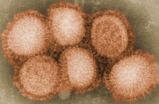(Press-News.org) Forecasts of when a volcano is ready to erupt could be a little closer thanks to work by
geologists at the University of California, Davis, and Oregon State University published online Feb.
16 in the journal Nature.
For an eruption to occur, the magma, or molten rock under the volcano must be sufficiently
mobile to erupt.
"The question is, what percentage of time is the magma in an eruptible state?" said Kari
Cooper, associate professor in the Department of Earth and Planetary Sciences at UC Davis and lead
author on the paper.
"People think about there being this big reservoir of liquid magma under a volcano, but we
don't think it's in that state all the time," she said.
The mobility of the magma depends on the amount of crystallization: When it is more than
about 50 percent crystalline, it becomes immobile. Crystallization, in turn, depends on the
temperature of the rock.
Until now, volcanologists have not known how common it is for magma to be crystalline
compared to being mobile and eruptible. The new work shows that at least for Mount Hood, Ore., the
magma is mobile less than 10 percent, and perhaps as little as 1 percent of the time.
Cooper and Adam Kent, professor of geology at Oregon State University, studied rocks ejected
from previous eruptions at Mount Hood. By analyzing both radioactive isotopes and the distribution
of trace elements, they were able to reconstruct the history of the rocks and the conditions to
which they had been exposed before they were erupted from the volcano.
VIDEO:
UC Davis volcanologist Kari Cooper talks about new studies of the magma reservoir under Mt. Hood, which could lead to a better understanding of volcanic activity and when volcanoes are...
Click here for more information.
The results mean that volcanologists might be able to better assess when a volcano is ready
to erupt by using seismic or other remote imaging to look for mostly liquid magma, Cooper said. If
eruptible magma is indeed relatively rare, then when it does appear, the risks of an eruption are
higher, she said.
Mount Hood is so far the only volcano studied in detail using these techniques. A preliminary
survey of data from similar volcanoes around the world shows that they likely follow a similar
pattern to Mount Hood, with mobile, "eruptible" magma only being present a small proportion of the
time. Cooper and Kent plan further studies to see if these discoveries are widely applicable or
unique to Mount Hood.
INFORMATION:
The work was funded by the National Science Foundation.
About UC Davis
For more than 100 years, UC Davis has been one place where people are bettering humanity and
our natural world while seeking solutions to some of our most pressing challenges. Located near the
state capital, UC Davis has more than 33,000 students, over 2,500 faculty and more than 21,000
staff, an annual research budget of over $750 million, a comprehensive health system and 13
specialized research centers. The university offers interdisciplinary graduate study and more than
100 undergraduate majors in four colleges — Agricultural and Environmental Sciences, Biological
Sciences, Engineering, and Letters and Science. It also houses six professional schools — Education,
Law, Management, Medicine, Veterinary Medicine and the Betty Irene Moore School of Nursing.
Additional media contact:
-- Kari Cooper, Earth and Planetary Sciences, (530) 754-8826, kmcooper@ucdavis.edu (Cooper is traveling until Feb. 17 and
best reached by e-mail.)
Mount Hood study suggests volcano eruptibility is rare
2014-02-17
ELSE PRESS RELEASES FROM THIS DATE:
Volcanoes, including Mt. Hood, can go from dormant to active quickly
2014-02-17
CORVALLIS, Ore. – A new study suggests that the magma sitting 4-5 kilometers beneath the surface of Oregon's Mount Hood has been stored in near-solid conditions for thousands of years, but that the time it takes to liquefy and potentially erupt is surprisingly short – perhaps as little as a couple of months.
The key, scientists say, is to elevate the temperature of the rock to more than 750 degrees Celsius, which can happen when hot magma from deep within the Earth's crust rises to the surface. It is the mixing of the two types of magma that triggered Mount Hood's last ...
River samples shed light on the spread of potential 'superbugs'
2014-02-17
The spread of antibiotic-resistance to one of the most pristine locations in Asia is linked to the annual human pilgrimages to the region, new research has shown.
Experts from Newcastle University, UK, and the Indian Institute of Technology in Delhi (IIT-Delhi), sampled water and sediments at seven sites along the Upper Ganges River, in the foothills of the Himalayas.
They found that in May and June, when hundreds of thousands of visitors travel to Rishikesh and Haridwar to visit sacred sites, levels of resistance genes that lead to "superbugs" were found to be about ...
New blood cells fight brain inflammation
2014-02-17
Hyperactivity of our immune system can cause a state of chronic inflammation. If chronic, the inflammation will affect our body and result in disease. In the devastating disease multiple sclerosis, hyperactivity of immune cells called T-cells induce chronic inflammation and degeneration of the brain. Researchers at BRIC, the University of Copenhagen, have identified a new type of regulatory blood cells that can combat such hyperactive T-cells in blood from patients with multiple sclerosis. By stimulating the regulatory blood cells, the researchers significantly decreased ...
Iowa State University's Wintersteen talks partnerships at national science meeting
2014-02-17
AMES, Iowa – Wendy Wintersteen, dean of Iowa State University's College of Agriculture and Life Sciences, spoke on Sunday of the importance of public-private partnerships in strengthening global food security during the annual meeting of the American Association for the Advancement of Science in Chicago.
During her talk, part of a panel on research and development for sustainable agriculture and food security, Wintersteen stressed the importance of partnerships in providing the innovation necessary to meet global challenges.
She said climate change, pests, plant ...
Scientists call for new stewardship of the deep ocean: Earth's last frontier
2014-02-17
The deep ocean, the largest domain for life on earth, is also its least explored environment. Humans are now encroaching more vigorously than ever into the ocean's deep regions, exploiting the deep's resources and placing its wealth of vibrant habitats and natural services for the planet at risk.
Lisa Levin, a biological oceanographer at Scripps Institution of Oceanography at UC San Diego, believes the vital functions provided by the deep sea—from carbon sequestration to nurturing fish stocks—are key to the health of the planet. As humans ramp up exploitation of deep-sea ...
Researchers rejuvenate stem cell population from elderly mice, enabling muscle recovery
2014-02-17
STANFORD, Calif. — Researchers at the Stanford University School of Medicine have pinpointed why normal aging is accompanied by a diminished ability to regain strength and mobility after muscle injury: Over time, stem cells within muscle tissues dedicated to repairing damage become less able to generate new muscle fibers and struggle to self-renew.
"In the past, it's been thought that muscle stem cells themselves don't change with age, and that any loss of function is primarily due to external factors in the cells' environment," said Helen Blau, PhD, the Donald and Delia ...
New 'pomegranate-inspired' design solves problems for lithium-ion batteries
2014-02-17
An electrode designed like a pomegranate – with silicon nanoparticles clustered like seeds in a tough carbon rind – overcomes several remaining obstacles to using silicon for a new generation of lithium-ion batteries, say its inventors at Stanford University and the Department of Energy's SLAC National Accelerator Laboratory.
"While a couple of challenges remain, this design brings us closer to using silicon anodes in smaller, lighter and more powerful batteries for products like cell phones, tablets and electric cars," said Yi Cui, an associate professor at Stanford ...
Worldwide study finds that fertilizer destabilizes grasslands
2014-02-17
Lincoln, Neb., Feb. 17, 2014 -- Fertilizer could be too much of a good thing for the world's grasslands, according to study findings to be published online Feb. 16 by the journal Nature.
The worldwide study shows that, on average, additional nitrogen will increase the amount of grass that can be grown. But a smaller number of species thrive, crowding out others that are better adapted to survive in harsher times. It results in wilder swings in the amount of available forage.
"More nitrogen means more production, but it's less stable," said Johannes M.H. Knops, a University ...
Study on flu evolution may change textbooks, history books
2014-02-17
A new study reconstructing the evolutionary tree of flu viruses challenges conventional wisdom and solves some of the mysteries surrounding flu outbreaks of historical significance.
The study, published in the journal Nature, provides the most comprehensive analysis to date of the evolutionary relationships of influenza virus across different host species over time. In addition to dissecting how the virus evolves at different rates in different host species, the study challenges several tenets of conventional wisdom, for example the notion that the virus moves largely ...
CU-Boulder stem cell research may point to new ways of mitigating muscle loss
2014-02-17
New findings on why skeletal muscle stem cells stop dividing and renewing muscle mass during aging points up a unique therapeutic opportunity for managing muscle-wasting conditions in humans, says a new University of Colorado Boulder study.
According to CU-Boulder Professor Bradley Olwin, the loss of skeletal muscle mass and function as we age can lead to sarcopenia, a debilitating muscle-wasting condition that generally hits the elderly hardest. The new study indicates that altering two particular cell-signaling pathways independently in aged mice enhances muscle stem ...





